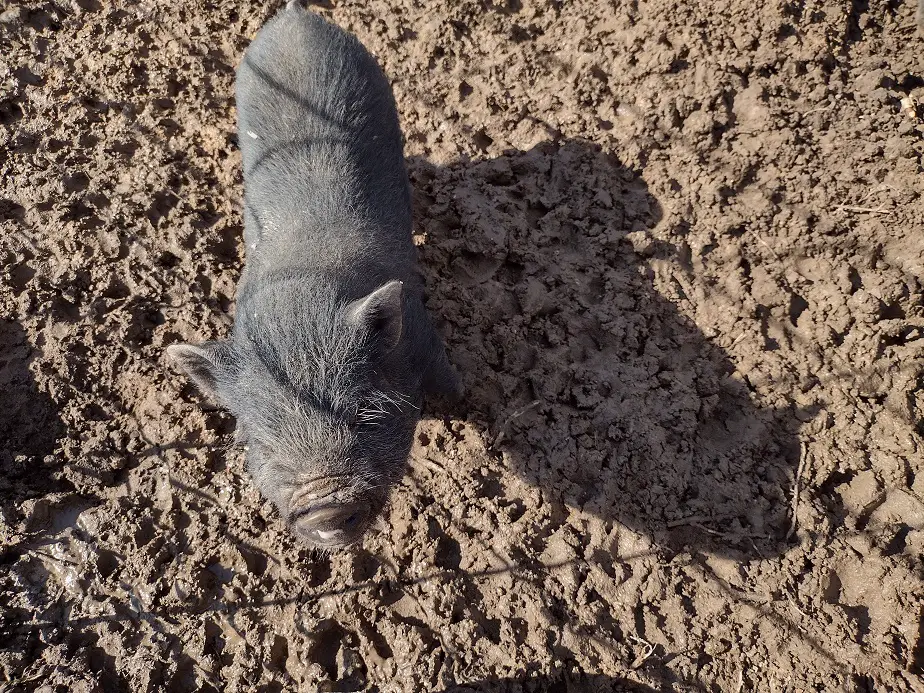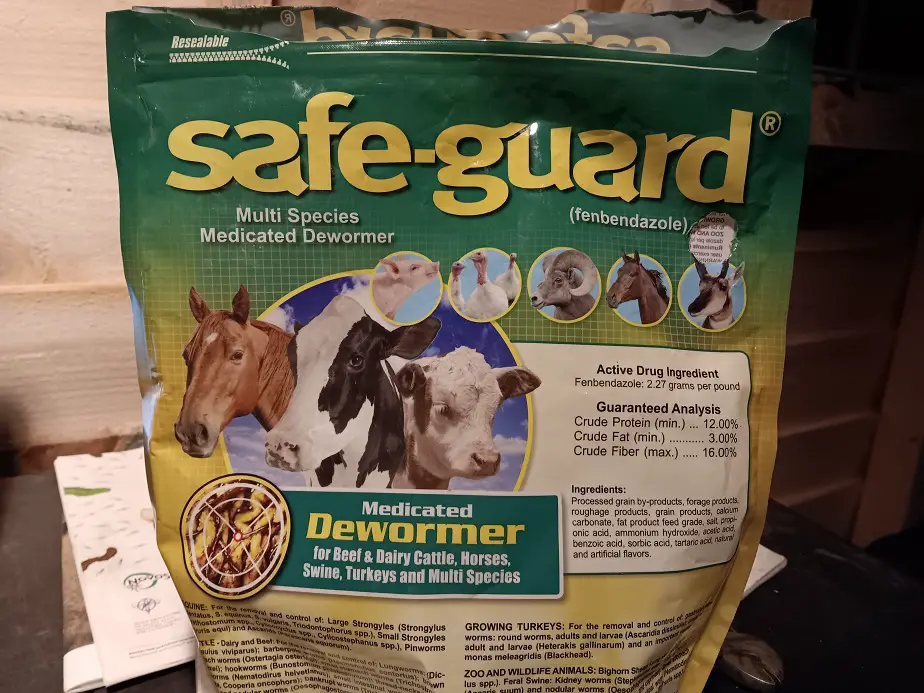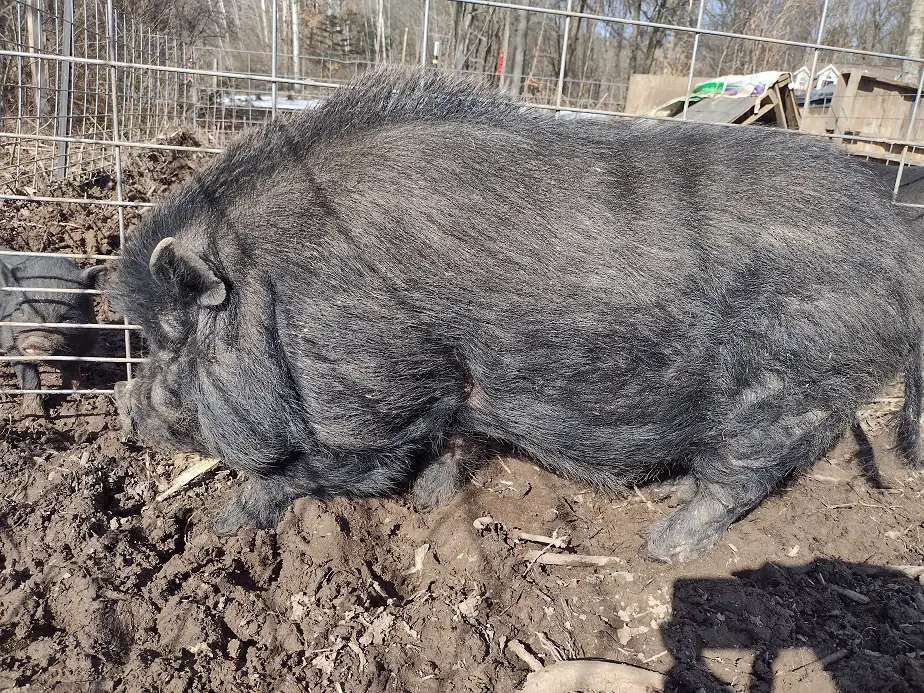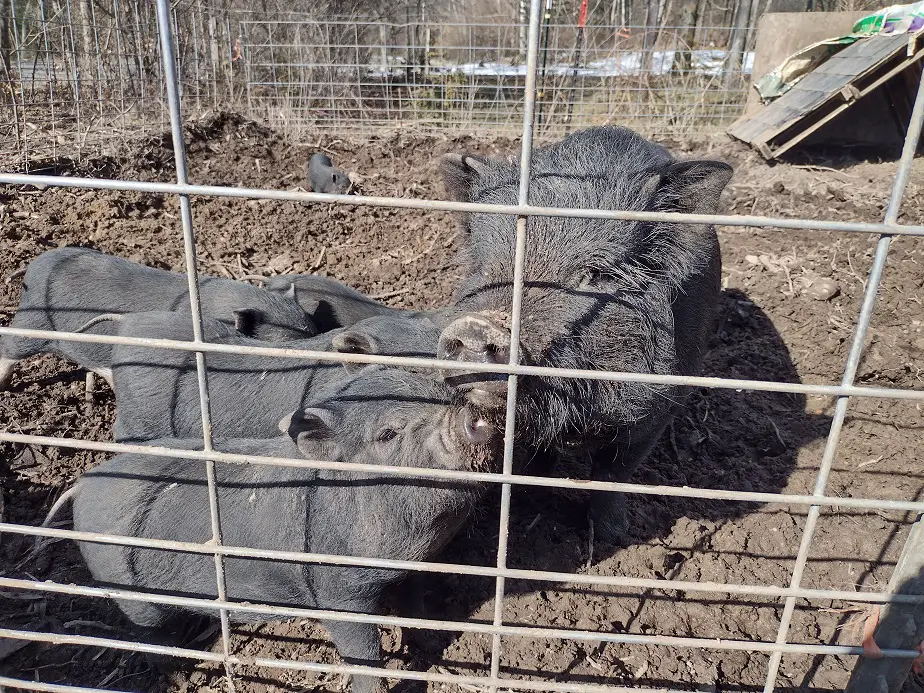We’ve raised litters of pigs on All-stock. Here’s what I learned.
Pigs can eat all-stock feed. It’s often low in protein for growing pigs or nursing sows, but it can still work. Pasture-type breeds do better on all-stock than large commercial hogs. Some all-stock is decent feed for pigs. Others may be considered a balanced base or pasture supplement.
Let’s cover the differences in all-stocks and when it may be a good option for you.
Should Pigs be Fed All-Stock Feed?
All-stock feed is grain-based, balanced with vitamins and minerals, and may have added protein and molasses for extra energy. None of that will pose a problem for pigs. Really, the main issue with all-stock for pigs is that it’s lower protein and often higher fiber than hog feed.
Pig feed is usually about 80 percent corn and 10 percent soy, with added vitamins, minerals, and sometimes a little oil. The added soybean gives it all the protein pigs need. All-stock is usually soy-free with various grains and/or grain by-products.
All-stock usually has processed grain by-products, dried distiller’s grain is the most common. It has a lot of fiber, moderate amounts of carbohydrates, and a lot of protein. It’s actually a fine ingredient for pigs. There’s usually some other grain added, which is also fine for pigs. That’s all good, wholesome energy.
Pigs can digest all-stock pretty well and they seem to like it too. Every company uses different ingredients in their feed, so check the label to see what’s in it. Pigs need lysine. Most all-stock doesn’t list the lysine content on. Sometimes you have to approximate based on the ingredients.

How Much Protein do Pigs Need?
Hog feed is between 14 and 18 percent protein with 1 to 2 percent lysine. All-stock is usually 12 percent protein and has anywhere between 0.5 and 1 percent lysine from what I’ve seen. There is a local brand here that lists 1 percent lysine, which is fine for pigs.
Its ingredients look like most other all-stocks in the area. It’s a 12 percent protein mix and the only source of protein is wheat middlings (used distiller’s grains). With that type of main ingredient, it probably has the lysine pigs need. Lysine is the largest growth-limiting amino acid for pigs, so it’s important.
You can add a little protein. The most common sources of good protein are soybean, peas, sunflower seeds, or meat products. Adding 5-10 percent by weight of any of these to an all-stock would make a high protein pig feed.
But, the overall protein is still low. Newly weaned pigs need the most protein. On a high-protein diet, weaned pigs are started on an 18 percent protein feed, then it’s lessened by 1 percent each month for 4 months (butcher age of 6 months). A lot of folks simply use a 16 or 15 percent from start to finish.
Pasture breed pigs have lower protein needs. They include Guinea Hogs, Kunekunes, and Pot-bellied Pigs. I have raised up several litters of put Pot-Bellied Pige on a 12 percent all-stock. They did pretty well. the pigs had pasture, so they ate a lot of grass, leaves, and other plant matter.
I used the all-stock for an energy and protein supplement to their pasture diet. The pigs showed no signs of protein deficiency such as tiredness and a stunted body. I got it about 50 percent cheaper than hog feed and was happy with the results. These days, we feed mostly fermented whole grains.
The first pig we raised was fed mostly a sweet all-stock. It had an all-stock pellet with a little cracked corn and oats, and molasses. It worked, but we also fed our kitchen scraps to that pig to help up the protein. We used it at the time because it was cheap. The pig was perhaps a bit small, but otherwhise healthy.

One thing you need for pigs, no matter your raising system, is a parasitic worm treatment. The best swine dewormer is Fenbendazole. It’s known by the brand name Safeguard. Safeguard is available as a medicated corn/alfalfa pellet. It’s the only way I can worm my pigs since they won’t stand still for an injection of Ivermectin. It’s easy and cheap.
- There is a stronger pellet for swine only. Here it is on Amazon
- There is a weaker pellet for general barnyard livestock, including swine. Here it is on Amazon.
I use the multi-species version because it’s what’s available in my local store and I can use it for my chickens too. It’s the most effective swine wormer and the easiest to administer. I use it on all weaned piglets and adults twice a year. Don’t go without it.

All-Stock vs Sweet Feed for Pigs
Sweet feed may have less lysine than all-stock, but they are usually quite similar. Some sweet feed is basically all-stock with molasses added, but some are pure grains rolled in molasses. Sweet feed is usually used to help animals increase body fat quickly.
It’s been said that sweet feed tends to cause pigs to fatten up too much. Well, that’s not entirely so. One would have thought so but the data clearly says otherwise. It can help pigs gain slightly more fat, but when they are already eating a high-grain diet, it makes little difference.
Here is a quote from a USDA research station on molasses in pig feed.
“Results of experiments by this station indicate that
Hawaii Agricultural Experiment Station, Bulletin 69, 1933.
in amounts up to 20 percent of the mixture fed fattening hogs, cane
molasses was worth approximately as much or more, pound for pound,
as the rolled barley which it replaced.”
Here’s another excerpt from a great research piece.
“Adding molasses at a low level, 10% of the diet, did not significantly alter rate of gain, efficiency of gain or backfat thickness”.
Journal of Animal Science, 1969
In theory, sugars like molasses are supposed to promote energy being stored instead of metabolized, but in the 6-7 months from birth to butcher it doesn’t seem to make much extra fat. I suppose it’s probably more of a factor after the first year growth spurt.
Sweet feed is usually 5 to 10 percent molasses by weight. The molasses doesn’t add extra calories by weight, but it does add extra calories and weight for the same volume of dry feed.
So, one pound of grain has the same calories as a pound of sweet grain. But, one quart of the sweet grain has more calories and weighs more than a quart of plain grain. Free feeding a sweet grain may result in pigs eating more calories, thus getting a little more fat.
Feeds containing a lot of molasses should be fed by weight more than volume. Or, keep a close eye on the condition of your animal. Adjust feed up or down depending on how the animal’s shape is looking.
Using all-stock isn’t on par with commercial standards. It can be part of an alternative pig-raising system. Consider the costs of different feed options in your area and weigh the options.
Related Articles:


I have recently moved from an animal reserve where my pet pigs ate fruit and veggies every day to a state that bans grocery stores from giving their produce to farmers, etc. Knowing that i can supplement their grazing with All Stock eases my concern for the boys nutritional intake. Just wish the article provided a guideline on how much to feed. Thanks
it realy depends. I would expect 2 to 3 percent of body weight worth of feed daily, split into two feedings. Adjust up or down depending on how the animal’s condition goes. Not all feeds are the same, not all pigs have the same metabolism.